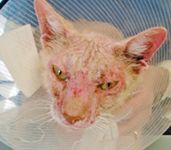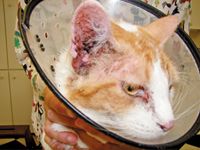Feline atopy-are you seeing more cases in your veterinary clinic lately?
Make sure you know the signs and veterinary treatment alternatives to corticosteroids.
Although the incidence of atopy in cats has been reported to be about l6 percent in past studies conducted at Cornell University and the University of Georgia, it seems that during the past few years at my practice we've seen an increase in the number of cats with this disorder. As in dogs, atopy is a diagnosis of rule-outs, and I hope the following discussion will help you diagnose and, consequently, treat feline atopy.

Dr. Alice M. Jeromin
What is atopy?
Atopy is defined as an inherited, exaggerated IgE response to inhaled or percutaneously absorbed antigens. IgE binds to mast cells, and, on reexposure to the antigen, cross linking occurs, causing mast cell degranulation. The release of other inflammatory products consisting of histamine, leukotrienes and prostaglandins accounts for the clinical signs.

Photo 1: Facial excoriation in an atopic cat.
The epidermal barrier also may play a role in establishing atopy in a patient. Atopic cats have increased CD4+ T lymphocytes in lesional skin, which supports the role of T helper type 2 (Th2) lymphocyte-mediated immunity in feline atopy (similar to in dogs and people).

Photo 2: Facial and ear excoriation in an atopic cat.
Characteristics of feline atopy differ from those in dogs in that the age of onset is extremely variable—from 6 months to l4 years old. The Devon Rex breed could be more prone, but there's no definitive breed or sex predilection. However, in our practice we tend to see atopy more often in orange or orange-color-containing cats, such as orange tabby, calico and tortoiseshell cats.

Photo 3: Groin erythema in an atopic cat due to excessive licking despite wearing an Elizabethan collar.
No set pattern of signs occurs in cats as it does in dogs, but the face, feet and perineum can be affected (Photos 1-3). On physical examination, atopic cats may show self-induced alopecia, miliary dermatitis, eosinophilic granuloma complex lesions, exfoliative dermatitis, chin acne with or without Malassezia otitis, seborrhea, eosinophilia or lymphadenopathy.
Difficult to diagnosis
The signs of atopy can mirror other diseases, such as dermatitis (flea allergy or Malassezia), Cheyletiella or Notoedres species infection, food allergy, dermatophytosis, demodicosis and pemphigus foliaceus. Most atopic cats are corticosteroid-responsive, but so are cats with the above differential diagnoses. Flea allergy dermatitis, cheyletiellosis, Notoedres species infection, demodicosis and dermatophytosis can largely be ruled out by performing skin scrapings, combings and trichography during the first appointment.
Taking a good history is essential since atopy tends to affect a patient at the same time every year—this can also be true for a flea allergy, especially in the Midwest where fleas tend to be eradicated in the cold winters. In a patient with nonseasonal signs, food allergy or allergy to dust mites should be considered once ectoparasites have been ruled out. Note that some food-allergic cats can be somewhat corticosteroid-responsive, so response to corticosteroids to rule out food allergy isn't dependable.
Testing tips
If a patient's history supports a diagnosis of atopy and the above-noted differential diagnoses have been ruled out, skin or serum testing is in order, particularly if the cat requires more than a minimum of corticosteroids annually. What constitutes a minimum of corticosteroids is a relative question. I prefer not to administer more than three methylprednisolone injections annually—and even less than that if there's any evidence of heart disease. Prolonged use of corticosteroids in cats may lead to diabetes or heart disease, and now that immunotherapy and cyclosporine are excellent alternatives to corticosteroids, hopefully those two diseases can be further prevented.
Become familiar with the laboratory you're using for the serum test, as each laboratory may have idiosyncrasies upon repeated use (e.g., false positive results to molds). Most important, the serum test results should coincide with the time of year the cat is affected. If the cat's signs are nonseasonal, the animal lives where there are set seasons, and the serum test result is negative to house dust mites, then rethink the diagnosis. The serum or skin test results must match the time of year the cat is affected. Otherwise, you won't be successful with immunotherapy.
Note, there's no definitive time that a patient should be off corticosteroids before testing. The timing depends on how long the cat has been receiving a corticosteroid, how sensitive the cat is to the corticosteroid and the corticosteroid's duration of activity. If the animal can go as long as possible off the corticosteroid before testing, you'll probably be OK.
Interpreting the serum test results can be challenging because not all cats register at the number the laboratory technician may think is the cutoff point. In some patients, if a cat registers some response to all of a particular class of pollen (e.g., all grasses), the results may be significant.
Treatment options
As noted, effective treatment can include immunotherapy or administration of cyclosporine or a combination of these.
Immunotherapy usually takes six to 12 months. Instruct the owner that if the cat is pruritic after an injection, the client needs to consult with you. We have seen cases in which cats were pruritic after the first injection and subsequently worse on each injection thereafter, yet a veterinarian told the clients to continue administration.
If a cat is pruritic after the first injection, it's possible the beginning vial is too strong and needs to be diluted. After an injection, you want to see the pruritus subsiding a bit and possibly increasing as the time approaches for the next injection. If the cat was pruritic after the injection but the pruritus subsided as the week went on, this signals the dose was too high. Sometimes during the patient's affected season, the dose should be reduced, particularly if what's in the injection is currently pollinating (visit www.pollen.com).
Cyclosporine, which is now FDA-approved for cats (Atopica—Novartis), is a good alternative to corticosteroids for atopic cats. Dosing can range from 2.5 to 7.5 mg/kg daily. The oral liquid can be given with or without food. Drug metabolism occurs in the liver and intestines, with excretion in the feces and a small amount of an inactive metabolite in the urine. The drug reaches steady state after one week.
Adverse effects include vomiting, regurgitation, weight loss, diarrhea, anorexia, lethargy and hypersalivation. In our practice we perform a complete blood count, serum chemistry profile, urinalysis, FIV and FeLV tests and toxoplasmosis IgM and IgG before starting the drug. Recrudescence of toxoplasmosis is possible in cats with cyclosporine levels > l,000 ng/ml, so it's a good idea not to use cyclosporine in outdoor cats or cats ingesting raw meat. We start most of our patients at 2.5 mg/kg daily, as we find many can be maintained on a daily dose of less than 5 to 7.5 mg/kg.
Once a cat has improved, we try to switch administration to every other day, and even less frequently later on in therapy. Blood work should be performed yearly, as should a physical examination that includes checking that cat's body weight and assessing for gingival hyperplasia, which appears to be more common in dogs receiving cyclosporine. The drug is useful in diabetic cats that have become atopic, but blood glucose monitoring still should be performed.
With atopy in cats appearing to be more prevalent, it's helpful to know there are safe alternatives to the former use of long-acting corticosteroids. Cats are not immune to the effects of corticosteroids as formerly thought, and educated pet owners may want to seek alternatives to these drugs.
Dr. Jeromin is a pharmacist and veterinary dermatologist in private practice in Cleveland, Ohio. She is a 1989 graduate of The Ohio State University College of Veterinary Medicine and an adjunct professor at Case Western Reserve University's College of Medicine in Cleveland.